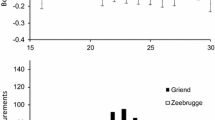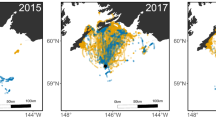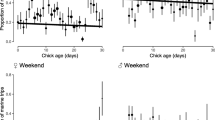Abstract
An experiment was designed to examine in a long-lived seabird, the thin-billed prion (Pachyptila belcheri), how adults adjust their food provisioning strategy when their foraging abilities are reduced and when the chick's needs are increased. To reduce the foraging abilities of adults we impaired their flying ability by removing some flight feathers (handicapped), and to increase the food needs of the chick one parent was retained (single). Birds made either short foraging trips lasting 1–3 days, or long trips lasting 5–9 days. Control birds alternated long and short trips whereas single birds or handicapped birds made several successive short trips and thereafter a long trip. In each treatment, food loads tended to be heavier after long trips than after short trips, and single birds tended to bring heavier loads than control or handicapped birds. Birds in the three treatments lost similar amounts of mass after short trips and gained similar amounts of mass after long trips. However, the mass of handicapped birds declined through the experiment, while that of control and single birds remained stable. Although the proportion of chicks that died during the experiment was similar among the three treatments, the chicks fledged by a single bird were lighter than those in control nests. The results of the experiment suggest that thin-billed prions adjust their breeding effort differently to decreased flying ability or increased food demand by the chick. Single birds increase foraging effort without allowing their condition to deteriorate. Conversely, handicapped birds are unable to maintain their body condition while sustaining the chick at the same rate as control birds. It is suggested that in this long-lived seabird, adults probably adjust their breeding effort so that they do not incur the risk of an increased mortality, this risk being monitored by the body condition.
Similar content being viewed by others
References
Chaurand T, Weimerskirch H (1994a) The regular alternation of short and long trips in the blue petrel Halobaena caerulea: a previously undescribed strategy of food provisioning in a pelagic seabird. J Anim Ecol 63: 275–282
Chaurand T, Weimerskirch H (1994b) Incubation routine, body mass regulation and egg-neglect in the blue petrel Halobaena caerulea. Ibis 136: 285–290
Drent RH, Daan S (1980) The prudent parent: energetic adjustment in avian breeding. Ardea 68: 225–253
Genevois F, Bretagnolle V (in press) Sexual dimorphism in the thinbilled prion Pachyptila belcheri. Notornis
Harris MP (1966) Breeding biology of manx shearwaters. Ibis 108: 17–33
ITCF (1988) STAT-ITCF, version 4. ITCF, Paris
Kacelnick A, Cuthill I (1990) Central place foraging in starlings (Sturnus vulgaris). II. Food allocation to chicks. J Anim Ecol 59: 655–674
Lack D (1968) Adaptations for breeding in birds. Methuen, London
Marchant S, Higgins PJ (1990) Handbook of Australian, New Zealand and Antarctic birds, vol IA. Oxford University Press Melbourne
Martins TLF, Wright J (1993a) Brood reduction in response to manipulated brood sizes in the common swift (Apus apus). Behav Ecol Socobiol 32: 61–70
Martins TLF, Wright J (1993b) Cost of reproduction and allocation of food between parent and young in the swift (Apus apus). Behav Ecol 4: 213–223
Norberg BA (1981) Temporary weight decrease in breeding birds may result in more fledged young. Am Nat 118: 838–850
Partridge L, Harvey P (1988) The ecological context of life history evolution. Science 241: 1449–1455
Pennycuick CJ (1982) The flight of petrels and albatrosses (Procellariiformes) observed at South Georgia and its vicinity. Phil Trans R Soc Lond B300: 75–106
Pennycuick CJ (1989) Bird flight performance. A practical calculation manual. Oxford University Press, Oxford
Perrins CM, Harris MP, Britton CK (1973) Survival of Manx shearwaters Puffinus puffinus. Ibis 115: 535–548
Rice DW, Kenyon KW (1962) Breeding cycles and behaviour of Laysan and black-footed Albatrosses. Auk 79: 517–567
Ricklefs RE (1990) Seabird life histories and the marine environment: some speculations. Colon Waterbirds 13: 1–6
Ricklefs RE (1992) The roles of parent and chick in determining feeding rates in Leach's storm petrel. Anim Behav 43: 895–906
Ricklefs RE, Day CH, Hutington CE, Williams JB (1985) Variability of feeding rate and meal size of Leach's storm petrel at Kent Island, New Brunswick. J Anim Ecol 54: 883–898
Saether BE, Andersen R, Pedersen HC (1993) Regulation of parental effort in a long-lived seabird: an experimental manipulation of the cost of reproduction in the antarctic petrel Thalassoica antarctica. Behav Ecol Sociobiol 33: 147–150
SAS Institute (1988) Release 6.04 SAS/STAT user's guide. SAS Institute, Cary
Siegel S, Castellan NJ Jr (1988) Non parametric statistics for the behavioral sciences. McGraw-Hill, New York
Stearns SC (1976) Life history tactics: A review of the ideas. Q Rev Biol 51: 3–47
Weimerskirch H, Zotier R, Jouventin P (1989) The avifauna of the Kerguelen Islands. Emu 89: 15–29
Weimerskirch H, Salamolard M, Sarrazin F, Jouventin P (1993) Foraging strategy of wandering albatrosses through the breeding season: a study using satellite telemetry. Auk 110: 325–342
Weimerskirch H, Chastel O, Chaurand T, Ackerman L, Hindermeyer X, Judas J (1994) Alternate long and short foraging trips in pelagic seabird parent. Anim Behav 47: 472–476
Williams GC (1966) Adaptation and natural selection. Princeton University Press, Princeton
Wright J, Cuthill I (1989) Manipulation of sex differences in parental care. Behav Ecol Sociobiol 25: 171–181
Ydenberg RC, Bertram DF (1989) Lack's clutch size hypothesis and brood enlargement studies on colonial seabirds. Colon Waterbirds 12: 134–137
Author information
Authors and Affiliations
Rights and permissions
About this article
Cite this article
Weimerskirch, H., Chastel, O. & Ackermann, L. Adjustment of parental effort to manipulated foraging ability in a pelagic seabird, the thin-billed prion Pachyptila belcheri . Behav Ecol Sociobiol 36, 11–16 (1995). https://doi.org/10.1007/BF00175723
Received:
Accepted:
Issue Date:
DOI: https://doi.org/10.1007/BF00175723




